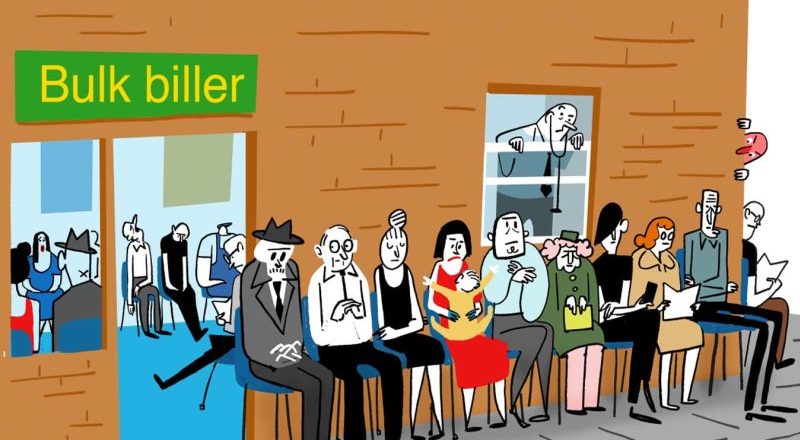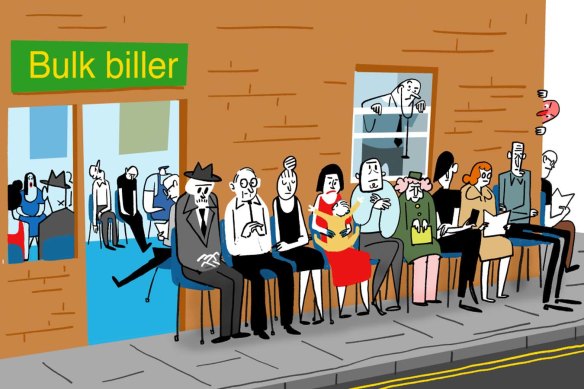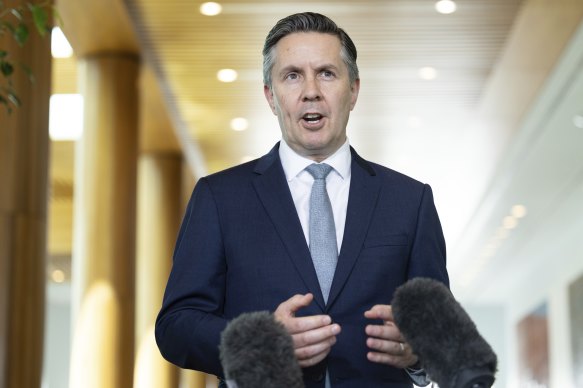If GPs want more money, they’ll have to be less allergic to change
Who’d be Anthony Albanese? Everywhere he looks, another problem. Now it’s the GPs. They’ve become a lot harder to get to see, and more expensive. Even getting them to return your call can take days.
It’s become so bad even the premiers are complaining. What’s it got to do with them? When some people find it too hard or costly to see a GP, they take their problem to a public hospital’s emergency department, where waiting times are long but there’s no charge.
Illustration by Simon LetchCredit:
Even the ambos are complaining that too many of their call-outs are to take someone with a minor problem to the emergency department.
The GP “crisis” was discussed at the national cabinet meeting on Friday, which received the final report of the Strengthening Medicare Taskforce. You can find the report on the internet but, although it’s mercifully short at 12 pages – with lots of lovely glossy photos of happy, good-looking Aussies – I doubt you’d find it very informative.
Remember the joke that a camel is a horse designed by a committee? The pictures suggest it’s intended for ordinary readers, but it’s written in bureaucratic code that would be crystal clear to any expert who already knew what it was saying.
You wade through guff about “access to equitable, affordable, person-centred primary care services” and “co-ordinated multidisciplinary teams” to find the odd bit you understand.
See if I do better. According to the doctors’ union, the AMA, the reason GPs have become so hard to find is that the federal government isn’t paying them enough. Whereas in the old days half of all medical graduates became GPs, now it’s down to about 15 per cent.
So, pay them more. Problem solved.
What the report’s saying is: sorry, not that simple. It’s true the Coalition government inherited a temporary freeze in Medicare rebates – the amount of a doctor’s bill that’s paid by the feds – in 2013, and continued it until 2018. And although the schedule of rebate payments has been increased annually since then, the increases have been much smaller than inflation.
In the old days, half of all medical graduates became GPs. Now it’s down to about 15 per cent.Credit:Getty Images
Why? Partly because the Liberals were trying to prove they could cut taxes without damaging “essential services” such as Medicare.
But also because they knew something was wrong with the way general practice works. They needed to pay GPs differently to do different things. Rather than pay more and more the old way, they’d hold back until they – or some future government – worked up the courage to make changes.
Over the almost 40 years of Medicare, there’s been a big change in the problems people bring to their GPs. Because we’re living longer, healthier lives, much more of our problems are chronic – someone with heart trouble or diabetes has to wrestle with it for the rest of their lives – rather than acute: something that’s easily and quickly fixed.
But the present (subsidised) fee-for-service way of remunerating doctors is designed to suit acute problems, not chronic conditions. It involves waiting for problems to arise, not early diagnosis or stopping chronic conditions getting worse.
It encourages GPs to keep consultations short, avoiding long discussions of multiple problems.
Minister for Health and Aged Care Mark Butler has not ruled out an increase to the Medicare rebate for GPs.Credit:Alex Ellinghausen
A change no one wants to talk about is the way sole practitioners or partnerships of doctors are giving way to companies owning chains of practices staffed by doctors they employ.
When you separate the person delivering the care from the person watching the bottom line, you increase the likelihood doctors are pressured to keep consultations short and order many tests – a further reason to be cautious about reinforcing GPs’ dependence on fee-for-service.
The report wants to move to “blended” funding, with acute consultations continuing to be fee-for-service, but GPs paid lump sums for developing and managing “care plans” for particular patients with chronic conditions.
While it’s true fewer medical graduates are becoming GPs, it’s not the whole truth. As the Grattan Institute reveals, “Australia has more GPs per person than ever before, more GPs than most wealthy countries, and record numbers of GPs in training”.
How do other countries with good healthcare get by with fewer GPs? By making sure their GPs can’t insist on doing things that could be done by other health workers – nurses, nurse practitioners (nurses trained to do some of the more routine things doctors do), pharmacists and physios.
This is what “co-ordinated, multidisciplinary team-based care” means. Changing GPs’ surgeries into more wide-ranging “primary care clinics” is also about making it easier for patients to move between different kinds of care, with GPs taking more responsibility for the total package, and all the various doctors and paraprofessionals having access to a patient’s medical history.
There’s nothing new about this. Federal governments have been trying to improve the performance of primary care for decades – with little success. Why? Because they’ve had so little co-operation from the premiers and the GPs themselves.
The true message of the latest report is: Medicare reform must not just be about more money to do the same things the same way.
Ross Gittins is the economics editor.
Ross Gittins unpacks the economy in an exclusive subscriber-only newsletter every Tuesday evening. Sign up to receive it here.
More original opinions
Home affordability: A third of the Australian population doesn’t own a home, two-thirds do: so which group do politicians want to look after? Is that why they can’t answer a very simple question about Australian house prices?
The energy gap: A recent breakthrough in the creation of nuclear fusion energy is good news for climate change, but what will human civilisation do to get through the next 20 or 30 years until it becomes a reality? And will we get there?
Quick exit: Australia’s young voters are walking away from the Coalition. How does the Liberal party get them back, and why are young Australians turning away from party values – individual freedom, equality of opportunity and reward for effort – in the first place?
Most Viewed in Business
From our partners
Source: Read Full Article




